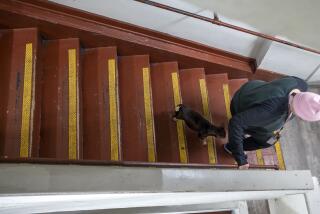Deal Struck to Raze Ambassador Hotel
Los Angeles school district officials and the L.A. Conservancy have reached a tentative deal to end the conservancyâs long battle to save the Ambassador Hotel -- allowing the district to tear down the building and replace it with a multi-school complex.
In exchange, the district would make a $4.9-million contribution to a nonprofit organization aimed at conserving historic school buildings in the district. The school district board is expected to vote on the proposed agreement today.
âWe will always believe that the Ambassador Hotel represents a tragic missed opportunity,â said conservancy Executive Director Linda Dishman. âBut having fought the good fight and lost, we decided to create something lasting.â
The deal, if approved, would clear the way for the school district to later this year demolish most of the sprawling hotel, where movie stars, politicians and royalty once mingled. It is perhaps best known as the site where Sen. Robert F. Kennedy was assassinated in 1968.
Under the terms of the agreement, a copy of which was obtained by The Times, the conservancy and a coalition of other local organizations would withdraw all their legal challenges to the districtâs demolition plans.
Now dilapidated, the Ambassador, with its Cocoanut Grove nightclub, was long the hot spot for the cityâs most glamorous and high-powered. Opened in 1921, the hotel was host to six Academy Awards ceremonies as well as countless movie stars and dignitaries, including Charlie Chaplin and Winston Churchill.
The district purchased the 24-acre property on Wilshire Boulevard in 2001 in U.S. Bankruptcy Court -- more than a decade after the hotel closed its doors. In 2004, a split school board narrowly approved plans to raze much of the complex to make way for its Heritage K-12 project -- a multi-school campus that would serve 4,200 students, offering some relief in one of the districtâs most overcrowded areas.
The conservancy and other groups quickly filed lawsuits to block the hotelâs destruction. As the cases ground their way through the courts, the Mexican American Legal Defense and Educational Fund and other supporters of the districtâs plan protested that the delay and legal costs would harm children waiting for the new schools. Members of Kennedyâs family sided with the Mexican American group, saying they wanted to see the schools built.
In July, the conservancy linked up with local, state and national politicians to urge the district to consider an alternative proposal that would have transformed the hotelâs main building into affordable-housing apartments and situated the schools along the lotâs perimeter. District officials and school board members, however, stood firm.
At the end of July, a Los Angeles County Superior Court judge dismissed the conservation groupsâ claims.
Instead of appealing that decision, Dishman said, the conservancy approached school district officials with the settlement plan, which calls for both sides âto settle fully and finally all existing claims
Glenn Gritzner, special assistant to Los Angeles Unified School District Supt. Roy Romer, said the districtâs contribution to the conservancy fund was a small price to pay to bring the battle over the Ambassador to a close.
âWhen this idea was presented, we thought it was reasonable and allowed us to do what we wanted, which was to get these schools built,â he said.
The $4.9-million contribution to the conservation fund, Gritzner said, would come out of the overall Heritage project budget, but he emphasized that the loss of funds would not impinge on building plans.
Nonetheless, Victor Viramontes, staff attorney for the Mexican American legal fund, expressed concern over the deal. âGetting these schools built is paramount,â Viramontes said, âbut we do not support spending more school construction dollars toward preservation.â
The districtâs contribution would be supplemented by a $100,000 âsign of good faithâ from the coalition of groups, Dishman said. Interest from the $5 million would be spent on rehabilitation and preservation efforts in the 50 district school buildings identified as historic in a 2002 conservancy survey. For example, Dishman said, funds could be used to restore a 1930s mural at Lincoln High School depicting Los Angeles.
Board members Mike Lansing and Jose Huizar said they would support the settlement. But member David Tokofsky, a vocal opponent of the district plan, said he had doubts.
âAnything that keeps us on the path of destroying this landmark and the history causes nothing but a wave of sadness and anger,â said Tokofsky, adding that he has yet to fully study the settlement.
The campusâ elementary school is scheduled to open in 2008, with the middle and high schools finished in 2009.
More to Read
Sign up for Essential California
The most important California stories and recommendations in your inbox every morning.
You may occasionally receive promotional content from the Los Angeles Times.











